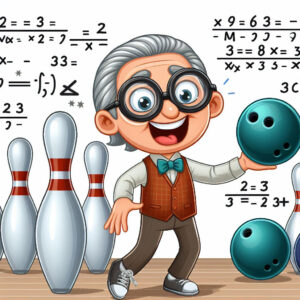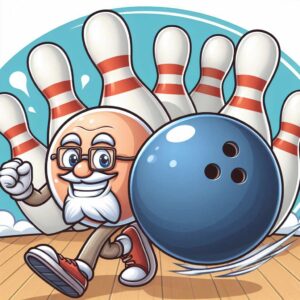Bowling is a beloved pastime enjoyed by millions around the world. Whether you’re a seasoned pro or a casual weekend warrior, having the right bowling ball can make all the difference in your game.
The perfect bowling ball should feel natural in your hand, roll smoothly down the lane, and provide the optimal amount of power and control for your unique playing style.
In this comprehensive guide, we’ll dive deep into the world of bowling balls, exploring the different types, key factors to consider when selecting one, and tips for measuring, fitting, and maintaining your equipment. By the end, you’ll have all the knowledge necessary to find the bowling ball that will take your game to the next level.
Types of Bowling Balls
The bowling ball market is a diverse one, with a wide range of ball types and designs to choose from. Understanding the differences between these options is crucial when trying to find the perfect fit. Let’s take a closer look at the main categories of bowling balls:
Solid vs. Reactive Resin
Bowling balls can be broadly classified into two main categories based on their coverstocks: solid and reactive resin.
- Solid bowling balls feature a durable, polished surface that provides a more predictable, consistent roll down the lane. These balls are often a great choice for beginner to intermediate bowlers, as they’re easier to control and offer a more forgiving reaction on the pins. Solid balls tend to be less expensive than their reactive counterparts.
- Reactive resin balls, on the other hand, have a rougher, more porous surface that grips the lane more aggressively. This allows them to generate more hook, or curved, motion as they approach the pins. Reactive balls are favored by experienced bowlers who have developed the skill to harness their increased backend reaction. While they offer more power and versatility, reactive balls also require more precision to wield effectively.
Particle vs. Smooth Coverstock
Another key distinction in bowling ball types is the coverstock texture – particle or smooth. Particle coverstocks contain small, abrasive pieces embedded in the resin, creating a gritty, textured surface. This enhances the ball’s ability to grip the lane and generate hook, making particle balls a popular choice for challenging oil patterns.
Smooth coverstocks, in contrast, have a polished, uniform surface that provides a more uniform, predictable roll. These balls tend to be better suited for lighter oil conditions, as they’re less likely to over-react on the backend. Smooth covers also require less maintenance than their particle counterparts.
Weight and Weight Blocks
Bowling ball weights can range anywhere from 6 to 16 pounds, with the optimal weight largely dependent on the bowler’s strength and skill level. Heavier balls (often 15 or 16 pounds) provide more power and momentum, making them a good fit for advanced players.
Lighter balls (6 to 14 pounds) are generally easier to control and are better suited for beginners, youth bowlers, and those with less physical strength.
The weight block, or core, of a bowling ball also plays a significant role in its performance. Asymmetric weight blocks create a more pronounced hook, while symmetrical weight blocks provide a smoother, more predictable motion. The placement and shape of the weight block can dramatically affect a ball’s dynamics and overall behavior on the lane.
Factors to Consider When Selecting a Bowling Ball
Now that we’ve covered the basic types of bowling balls, let’s dive into the key factors you should consider when choosing the right one for your game.
Skill Level
Your current skill level as a bowler is perhaps the most important consideration when selecting a bowling ball. Beginner bowlers should opt for balls that are easier to control, with solid coverstocks and symmetrical weight blocks. These provide a more forgiving, consistent roll that’s less likely to hook dramatically.
As you progress in your bowling abilities, you can start experimenting with more advanced ball types, such as reactive resin and asymmetric weight blocks.
These offer increased power and backend reaction, but also require more precision and technique to wield effectively. Intermediate and advanced players often have a range of ball options to choose from, allowing them to match the right ball to the specific lane conditions.
Ball Weight
Determining the appropriate ball weight is crucial for both comfort and performance. As a general rule, your bowling ball should weigh no more than 10% of your body weight. This ensures that the ball is heavy enough to generate power and momentum, but light enough for you to control and swing comfortably.
Factors that can influence the ideal ball weight include your physical strength, release style, and ball drilling. Stronger bowlers with a smooth, controlled release may be able to effectively use heavier 15- or 16-pound balls, while those with a more powerful, less consistent swing may fare better with a 14-pound or even 12-pound ball.
It’s important to note that the weight of the ball should also match your comfort level. A ball that’s too heavy can lead to fatigue, inconsistent releases, and potential injury over time. Taking the time to try out different weights at your local bowling alley is highly recommended before making a purchase.
Ball Layout and Drilling
The layout and drilling of a bowling ball – that is, the placement and angle of the finger holes – can have a significant impact on its performance. Understanding ball dynamics and how different layouts affect the ball’s motion is crucial for maximizing your score.
The position of the weight block within the ball, as well as the spacing and angle of the finger holes, determines the ball’s overall reaction on the lane. Asymmetric weight blocks, for example, create a more pronounced hook, while symmetrical weight blocks provide a smoother, more predictable roll.
Consulting with a professional ball driller or coach can help you determine the optimal layout for your unique playing style and release mechanics. They’ll take into account factors like your hand size, finger span, and preferred grip type to ensure a custom fit and optimal ball motion.
Ball Surface and Finish
The surface and finish of a bowling ball can also have a significant impact on its performance, particularly in response to different lane conditions.
Coverstocks with a rougher, more porous texture – such as particle or reactive resin – grip the lane more aggressively, generating increased hook and backend motion. These balls tend to excel on heavier oil patterns, where their ability to cut through the oil can provide a competitive advantage.
Smooth, polished coverstocks, on the other hand, are better suited for lighter oil conditions. They offer a more uniform, predictable roll that’s less likely to over-react on the backend. Bowlers who frequently compete on “fresh” or lightly oiled lanes may find these balls to be a better match for their needs.
It’s worth noting that the surface of a bowling ball can also be modified and adjusted over time through sanding, polishing, and other resurfacing techniques. This allows bowlers to fine-tune their equipment to adapt to changing lane conditions and their own evolving playing styles.
Measuring and Fitting a Bowling Ball
Once you’ve determined the right type of bowling ball for your skill level and playing style, the next crucial step is ensuring a proper, comfortable fit. A well-fitted ball can make a significant difference in your accuracy, power, and overall performance on the lanes.
Getting Your Hand Measured
The first step in finding the perfect bowling ball fit is to get your hand professionally measured. This involves taking precise measurements of your fingers, including the length, span, and circumference.
A qualified pro shop or bowling center staff member can guide you through this process, ensuring accurate measurements that will translate to a custom-fitted ball.
Choosing the Right Grip Type
Based on your hand measurements and personal preferences, you’ll then need to decide on the appropriate grip type for your bowling ball. The three most common grip options are:
- Fingertip grip: The most common grip, where only the fingertips are inserted into the ball’s finger holes.
- Conventional grip: The fingers are inserted deeper into the ball, with the second knuckle resting in the holes.
- Palm grip: Also known as a “three-finger” grip, where the thumb and two fingers are inserted into the ball.
Each grip type offers its own unique advantages and drawbacks, so it’s important to try out different options to determine what feels most natural and comfortable for your hand and release.
Ensuring Proper Weight and Balance
In addition to the grip, the weight and balance of the ball must also be carefully considered. As mentioned earlier, the ball should weigh no more than 10% of your body weight to ensure optimal control and comfort.
Beyond the overall weight, the ball’s weight distribution and balance point are critical factors. A properly balanced ball will feel natural and stable in your hand, with the weight evenly distributed. An imbalanced ball can lead to inconsistent release and unpredictable roll behavior.
Maintaining and Caring for Your Bowling Ball
Purchasing the perfect bowling ball is only half the battle – properly maintaining and caring for your investment is just as important. With the right maintenance routine, you can keep your ball performing at its best for years to come.
Cleaning and Polishing Techniques
Regularly cleaning and polishing your bowling ball is essential for preserving its surface condition and maximizing performance. This involves using specialized cleaners and polishing pads to remove dirt, oil, and other contaminants that can accumulate over time.
It’s recommended to clean your ball after every session, using a mild detergent or ball cleaner and a soft cloth or pad. More thorough resurfacing, such as sanding or polishing, should be done periodically (every 20-30 games) to restore the ball’s original shine and texture.
Adjusting Ball Surface as Conditions
Change In addition to regular cleaning, you may need to adjust the surface of your bowling ball to adapt to changing lane conditions. This can be done through sanding, polishing, or the application of different types of ball finishes.
For example, if you’re competing on a heavily oiled lane, a more aggressive, textured surface may be beneficial to provide increased grip and hook. Conversely, a smoother, more polished finish may be better suited for drier, “burnt” lane conditions.
Consulting with a professional ball driller or pro shop staff can help you determine the optimal surface adjustments for the specific lanes and patterns you’ll be facing.
When to Consider Drilling a New Ball
While proper maintenance can extend the lifespan of your bowling ball, there will come a time when you’ll need to consider drilling a new one. This may be due to factors such as:
- Significant wear and tear on the ball’s surface
- Changes in your playing style or release mechanics
- Desire for a different ball type or weight
- Damage to the ball’s core or drilling
Paying attention to your ball’s performance and comfort level can help you identify when it’s time for a replacement. Consulting with a qualified pro shop can also provide valuable guidance on when a new ball may be warranted.
Recommendations and Buying Tips
With so many bowling ball options on the market, it can be overwhelming to know where to start when it comes to making a purchase. Here are some top-rated ball models and key features to look for:
Top-Rated Bowling Ball Models
- Solid Balls: Brunswick Rhino, Hammer Black Widow, Ebonite Maxim
- Reactive Resin Balls: Storm Phaze III, Roto Grip Hustle PRO, Motiv Trident Abyss
- High-Performance Balls: Storm Hy-Road, Roto Grip Hustle INK, Hammer Black Widow Legend
When evaluating these and other ball options, pay close attention to the coverstock type, weight block design, and overall ball motion characteristics to ensure it aligns with your skill level and playing style.
Where to Purchase High-Quality Bowling Balls
The best place to purchase a new bowling ball is at a reputable pro shop or sporting goods store with knowledgeable staff. These establishments can provide personalized fittings, drilling services, and expert advice to help you find the perfect ball.
Online retailers like bowling.com and bowlingball.com also offer a wide selection of bowling balls, often at competitive prices. However, it’s important to ensure proper fit and drilling when ordering online, so consider visiting a pro shop first to get measured before making a purchase.
Key Features to Look for When Buying a New Ball
In addition to the ball type and weight, some other key features to consider when shopping for a new bowling ball include:
- Core design (symmetric vs. asymmetric)
- Coverstock technology (particle, reactive resin, etc.)
- Ball finish (shiny, matte, etc.)
- Drilling and layout options
- Warranty and manufacturer support
By keeping these factors in mind, you’ll be well on your way to finding the perfect bowling ball that will help elevate your game to new heights.
Conclusion
Choosing the right bowling ball is a crucial step in taking your game to the next level. By understanding the different ball types, key selection factors, and proper fitting and maintenance techniques, you’ll be equipped with the knowledge to find the perfect ball for your unique playing style and skill level.
Remember, the “perfect” bowling ball is the one that feels natural in your hand, rolls smoothly down the lane, and helps you maximize your performance consistently. Don’t be afraid to experiment with different options and seek out expert guidance until you find the ball that’s the perfect match.
Happy bowling, and may your strikes be plentiful!





